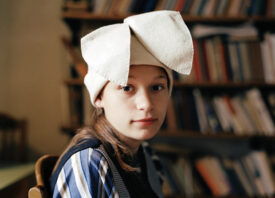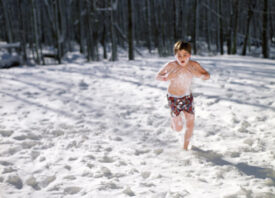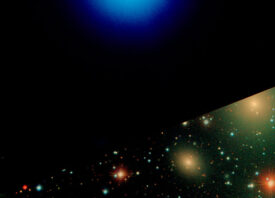Search this site
Artist Peels Back the Mask to Explore the Layers of Self

Whenever I look at this work by photographer Monika Chabicovsky, the line from the song New York Cares by Interpol plays in my brain: “I had seven faces. Thought I knew which one to wear.”
The song is melancholy and deals with the struggles of living authentically in New York City, whereas in Chabicovsky’s series entitled “The Two Sides of the Truth,” I take away an inspiring call to explore.
By day, Chabicovsky is a toxicologist working as a consultant for the biotech industry. In this work, she portrays her struggle with the rational side of self (work, work, work) vs. the creative/fine art photographer side that wants to play. The struggle is real, even if some of us do not know we are engaged with it.
If you’re familiar with Swiss psychiatrist and psychoanalyst Carl Jung and his theories of “persona” and “individuation,” this series and interview will seem very relatable.
Like Chabicovsky, Jung also struggled with play. In his memoir “Memories, Dreams, Reflections” he writes that he only gave in to play after “endless resistances” and with “a sense of recognition”. He says: “For it was a painfully humiliating experience to realise that there was nothing to be done except play childish games.”

What was the inspiration for this series?
‘ThIs project began in 2020 during a time when I was really struggling to balance my creative pursuits with my professional life. The rational side of me kept insisting that I focus on my business, leaving little room for making art. This internal conflict became the driving force behind my ongoing series The Two Sides of The Truth, where I seek to explore and reconcile my opposing “parts.”’

How do your self-portraits challenge typical/traditional notions of identity?
‘My self-portraits disrupt traditional notions of identity, acknowledging it as fluid, multifaceted, and often contradictory. Rather than portraying a single, unified oneness, I explore the tension that results from engaging with differing aspects of my identity — reason versus emotion, science versus creativity, persona, and the authentic self.
‘I question the stability of identity and how much of it is shaped by societal expectations versus internal realities. This challenges the idea of identity as something fixed or singular and instead presents it as dynamic and layered.’

Have you discovered aspects of yourself you hadn’t considered before starting this project?
‘Creating these self-portraits is fun, and I discovered how much I enjoy the process of planning and playing—choosing the right dress, outfit, and concept for each shoot. For a long time, I didn’t allow myself to embrace a sense of play.’

How do you use visual metaphors to convey abstract concepts like reason, emotion, or duality?
‘I use simple visual elements to represent complex concepts like reason, emotion, and duality. Masks, for example, serve as a central metaphor for the duality that lies between persona and authenticity, blurring the line between what is hidden and what is revealed.
‘I also play with functional contrasts — light and shadow, rigid shapes versus soft textures — to reflect the tension between order, reason, and emotion. Hopefully, my visual language invites the viewer to think about how they see — and live out — their own inner conflicts and truths.’

Are there any recurring symbols in your images? If so, what do they represent?
‘I use masks to represent different facets of the self and to explore the relationship between our different selves — the contrasts as well as interconnectedness. The masks also blur the line between fiction and “truth,” inviting the audience to engage with these universal themes on a deeply personal level.’
Which came first: the images or the captions?
‘The first image, created in 2020, is titled “Me Telling Me What to Do” and reflects my daily struggle. The image presents the core of the ongoing tension between rational, scientific thinking — quick, focused, and efficient — and the fine art photographer who delves into the world of emotions, taking time to explore and embrace a quieter, more deliberate pace.’

What do you hope viewers will take away when reflecting on their masks and “complicated truths”?
‘Through this project, I explore the multiple realities and midpoints that shape my own identity, while encouraging the audience to peel back their own masks and confront their own personal truths, however complicated and uncomfortable they may be.’

Have you received any surprising or impactful reactions from viewers about the series?
‘Some viewers have asked why I haven’t explored creating diptychs, triptychs, or even a full narrative storyline instead of focusing on single images. This feedback is inspiring, and it’s something I’ll be experimenting with as this project evolves. It also opens the door to exploring the use of triptychs, their meaning, and how they function within the history of art, so stay tuned!’
What questions do you hope your audience will ask themselves after viewing your work?
‘I hope people take a moment to consider their own “two sides of the truth.” Who are you, truly? What lies beneath the masks you wear every day? The Two Sides of the Truth invites viewers to explore the layers of their own personas, accepting what can be complex, dynamic aspects of their own.’



